A380 The final countdown.
-
wooohooo

-
Damn I can't see the ceremony at work

-
Hi polar!Originally posted by polarsnake:Damn I can't see the ceremony at work
 You're not missing much la really.
You're not missing much la really. 
-
Finally delivered!

And the first class suite is AMAZING!

-
Yea... Mahagony wood...Originally posted by alleggerita:Finally delivered!
And the first class suite is AMAZING!


-
I also at work, but I watch secretly..Originally posted by polarsnake:Damn I can't see the ceremony at work

-
Not only that..they literally have their own "rooms" and a full-size bed plus there's really a mattress!Originally posted by wonderamazement:Yea... Mahagony wood...


-
But one thing though..is all the space of the two decks used for First Class, Business Class and Economy Class seatings? No place for leisure like bars or spas, massage parlours or duty-free shopping?

I thought they say they'll be using some space for other purposes..
-

AFTER repeated delays, Airbus delivered its first A380 superjumbo jet to Singapore Airlines (SIA), its first airline customer on Monday - two years late and more than 15 years after its maker first unveiled plans for the world's largest passenger plane that would revolutionise air travel.
SIA received the 'keys' to the very first A380 - a double-decker jet that is as long as a soccer pitch, with a tail seven storeys high - in a glitzy media event at the Airbus headquarters in Toulouse, France.
Some 500 guests and journalists were treated to a two-minute long light and sound show that preceded the handover, which marks the culmination of an engineering project unrivalled in the aerospace industry. Sixteen airlines have so far ordered 189 of the giant birds that can each carry more than 500 passengers in a three-class configuration.
SIA, which has signed for 19 of the superjumbos to the tune of US$5.7 billion, is fitting its A380 with just 471 seats - 12 luxury suites on the main deck, 60 in business class on the upper deck and 399 in economy class on both decks.
Monday's handover was followed by the much-anticipated tour of interior of he plane that drew a chorus of wows, especially when the guests were shown the front-end suites that offer "a class beyond first" experience.
Each first-class suite will feature private rooms with double beds - a seat and a separate bed which is stowed against the cabin wall when not in use.
Travellers in business and economy class will also get more comfort, with the widest seats and biggest personal entertainment screens the sky has to offer.
The extra luxury comes at a price. At the top end, travellers can expect to pay over 20 per cent more although the increases will be more moderate for the economy class.
SIA CEO Chew Choon Seng told the Singapore media ahead of the delivery: 'Where the amount of cabin space given to each passenger has increased, we will of course also have to recover our costs.'
The A380's inaugural commercial flight has been set for Oct 25 from Singapore to Sydney. SIA has auctioned all seats on the first flight on eBay, raising about US$1.25 million for charity. It will fly later to London and Tokyo.
The entry of the superjumbo will help ease capacity constraints that the industry has faced because of the delivery delay and a buoyant air travel business.
Despite the delays, SIA has been impressed with the technological marvel and intends to make the A380 the 'backbone of its long-haul operations' said Mr Chew.
'The A-380 is the first all-new big aircraft design in more than 35 years and the application of the latest technologies, of the advancements in aerodynamics, of everything else that goes into modern aircraft design has great appeal for SIA.'
Airbus has sold airlines on the A380's efficiency, boasting it consumes 12 per cent less fuel than the B-747 and costs 15 per cent less to operate.
The jet runs on less than 3 litres of fuel per passenger over 100km - less than a hybrid car - while its take-off noise level is half that of the B-747.
Mr Chew said: 'From what i have seen and what my colleague tell me, I think the A-380 has been well worth waiting for...This is a proud moment, a happy occasion for SIA and we are privileged to have the opportunity to help write a new chapter in aviation history.'
Airbus started building the A-380 in the early 1990s, banking on a massive growth in air traffic between major hubs.
The aircraft has three floors, connected by stairs in the front and rear.
Passengers will be seated on the two top decks, while the bottom deck carries cargo.
As well as unprecedented space, arch-rival Boeing, meanwhile, has a very different idea of the future, predicting that passengers will prefer to fly directly to their destinations, rather than via capital cities, and plans a new generation of smaller long-range aircraft. -


The new 'a class beyond first' suites offers luxury travellers their own private designer cabins - complete with a full-sized bed, Givenchy-design duvets and cushions and their own personal 23-inch LCD screens. -- PHOTO: SIA -
its a flying hotelOriginally posted by vIn.Warrior:

The new 'a class beyond first' suites offers luxury travellers their own private designer cabins - complete with a full-sized bed, Givenchy-design duvets and cushions and their own personal 23-inch LCD screens. -- PHOTO: SIA
-
or rather...a flying cruise ship.......Originally posted by Dead_Man_Inc:its a flying hotel

-
Ya can any insider or someone close to the source confirm this?Originally posted by alleggerita:But one thing though..is all the space of the two decks used for First Class, Business Class and Economy Class seatings? No place for leisure like bars or spas, massage parlours or duty-free shopping?
I thought they say they'll be using some space for other purposes..
There's really nothing but seats and beds and tables on SIA's A380s? -
First commercial flight in : 9 DAYS
-
No first class, SIA goes for suite class
Tuesday • October 16, 2007
Leong Wee Keat in Toulouse, France
[email protected]
IN SINGAPORE Airlines (SIA) chief executive Chew Choon Seng's view, it "was well worth the wait".
Against the backdrop of sunny skies here and in the global aviation scene, the world's largest passenger plane was handed over, after an 18-month delay, to the airline yesterday.
Half again as huge as a Boeing 747, the A380 first appeared on Airbus' drawing board in 1996. It is the European aircraft manufacturer's most ambitious project to date and a critical step in its efforts to rebound from a string of troubles.
While the aerial mammoth is capable of carrying 800 passengers in its double-decker fuselage, SIA has fitted its first ten A380 planes with just 471 seats.
Both Airbus and SIA declared the aircraft would revolutionise flying comfort — featuring, for instance, the new Singapore Airlines Suites, which are designer-cabins with full-sized beds (picture).
The aircraft would also be kinder on its surroundings, promising to be greener and less noisy.
The handover marked the first time in almost 35 years that another jumbo plane has been rolled out. The last was the 747 model by Boeing in the early 1970s.
The A380's arrival, however, has been hit by turbulence along the way. The delivery of the first plane was affected by multiple delays, wiping almost US$6 billion ($8.8 billion) from the group's balance sheet.
And the jury is still out on whether the new kid on the aviation block will truly revolutionise the aviation industry, say analysts.
Mr John Nance, an aviation analyst in the United States, told AFP that while the aircraft was "a magnificent achievement", it was "a white elephant".
Singapore analyst Prithpal Singh pointed out that the A380 would connect high-density long haul points around the world. "With more and more airports in these high-population cities getting very busy and congested and slots insufficient, the A380 will serve these routes very well," he told TODAY.
But SIA and Airbus are convinced the A380 will be the face of the aviation future.
Airbus president and chief executive Thomas Enders called the aircraft a "huge step ahead in environmental performance" – it uses about 2.9 litres of fuel per passenger per 100km, about the same as a small family car, while creating half the noise.
Mr Chew said the A380 would form the backbone of the airline's future long-haul operations. SIA has 19 firm orders for the A380 valued at US$5.7 billion at catalogue prices.
While he acknowledged Boeing's 747 as "still a good plane", Mr Chew said the A380 embodied all the technological advances of the past 30 years. "This is the plane for today and tomorrow," he said.
While the nearly two-year delay in delivery created "inconveniences" for the airline, Mr Chew said the extra time had helped Airbus hand over a "more mature plane".
"This plane has done more test flights and test try-outs at more airports than other new aircraft programs in the last 30 years," he said.
SIA's new giant child will now head home, landing at Changi Airport tomorrow evening. It will then take off on Oct 25 on special charity flights between Singapore and Sydney, before entering into scheduled service three days later.
SIA will take over at least five A380s from Airbus by the end of next year. The flag carrier plans to use the second and third A380s on the Singapore-London route, while the fourth would ply the Singapore-Tokyo route. The fifth and sixth A380s will eventually service the Singapore-Hong Kong-San Francisco route on a daily basis.
Analysts expect the A380's arrival to ease SIA's seat crunch, at a time when strong passenger demand, particularly in premium traffic, has outstripped industry supply. In SIA's September operating results released yesterday, passenger capacity fell by 0.5 per cent year-on-year, due in part to the reduction of the number of B747-400 aircraft in its fleet.
Airports that have upgraded their infrastructure to support the jumbo A380s also stand to gain, said Citigroup's aviation analyst Corrine Png. "These airports will also benefit from the boost in passenger movements at the airports, in terms of higher revenue from airport taxes, retail and F&B concession revenues," she said.
Sidebar:
IT'S a luxurious way to join the mile-high club, if you can afford it.
As the airline unveiled the inside of its new Singapore Airlines Suites -- private cabins that go "beyond the luxury of First Class" -- the loudest Ooohs and Aaahs were reserved for the plush leather seats that converted into a double bed.
Asked if SIA would introduce packages for newlyweds, chief executive Chew Choon Seng said with a laugh: "You have given us some ideas."
Each seat in a Singapore Airlines Suite, designed by leading French luxury yacht designer Jean-Jacques Costeis, is almost a metre wide, and the seats in the two adjoining middle suites can be converted to a double-bed.
Each suite can also be transformed into a stylish office in the sky – furnished with a table that can function as a workstation, and be transformed later into a meeting table or dining table topped with fine-bone China and crystal ware.
The main deck of the A380 will house 12 suites. The plane also offers 60 business class seats and 399 economy class seats, all of which come with extra legroom. Business class passengers can also socialise and select snacks at a special corner.
Such pampering has a price – in this case, a 20 to 25 per cent premium on Suites and Business Class tickets, and about 10 per cent more on economy class.
But Mr Chew expects the unit costs for the A380 to eventually come down, adding: "Hopefully, that can translate into more competitive pricing." -
First 10 A380s SIA is getting will be fitted in this way and with Rolls-Royce Trent 900 engines..the other 9 firm orders they haven't decide on interior layout and engine..so maybe the other 9 confirmed orders will have a different cabin layout..Originally posted by Vigelic:Ya can any insider or someone close to the source confirm this?
There's really nothing but seats and beds and tables on SIA's A380s?
Other than these 19 firm orders, we have another 6 planes on option is it?
And BTW, what's the meaning of "on option"? Meaning they can cancel the orders if they want to? -
singapore must be number 1 in everything !!!
so must be the 1st in the world to get the 1st A380
but with the every increasing fuel....i wonder if it would ???? to SIA -
This new A380 is meant to be greener and more fuel efficient ma..Originally posted by pqr:singapore must be number 1 in everything !!!
so must be the 1st in the world to get the 1st A380
but with the every increasing fuel....i wonder if it would ???? to SIA
-
Here's a picture of SIA's first A380 followed by the next 5 A380S SIA's going to get..Their registration is as follows, 1st: 9V-SKA, 2nd: 9V-SKB, 3rd: 9V-SKC, 4th: 9V-SKD, 5th: 9V-SKE, 6th: 9V-SKF..

The 5th and 6th aircraft (9V-SKE and 9V-SKF) only half built, no engines and cannot fly yet..but 2nd to 4th aircraft (9V-SKB to 9V-SKD) already had their first flights..left painting and interior fittings I guess..
1st A380: 9V-SKA aka MSN003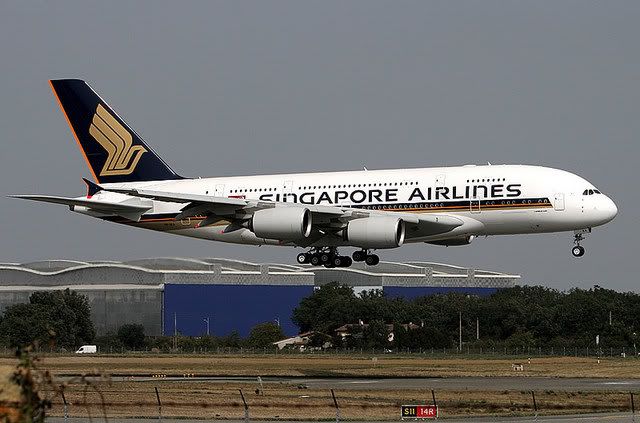
2nd A380: 9V-SKB aka MSN005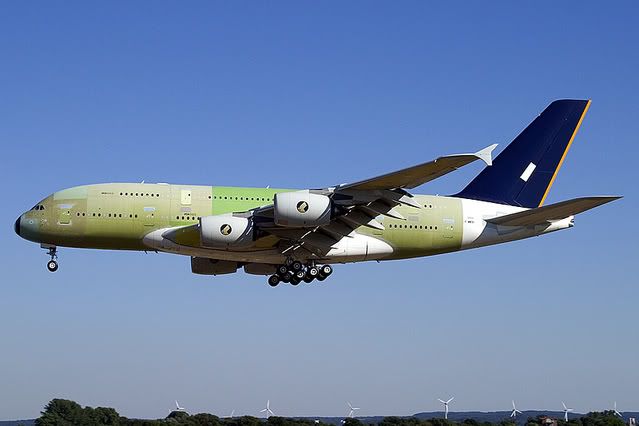
3rd A380: 9V-SKC aka MSN006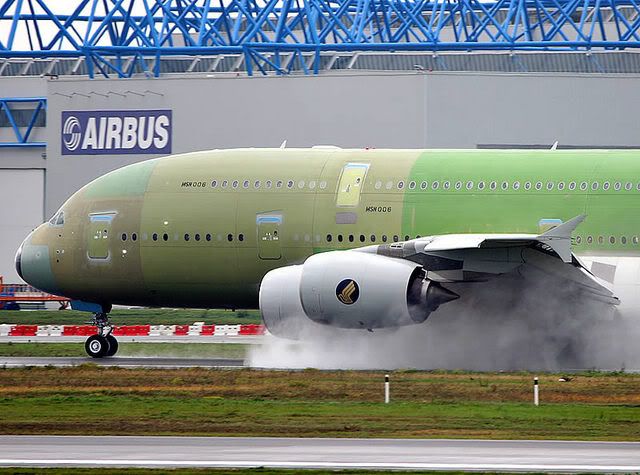
-
Continue...........
4th A380: 9V-SKD aka MSN008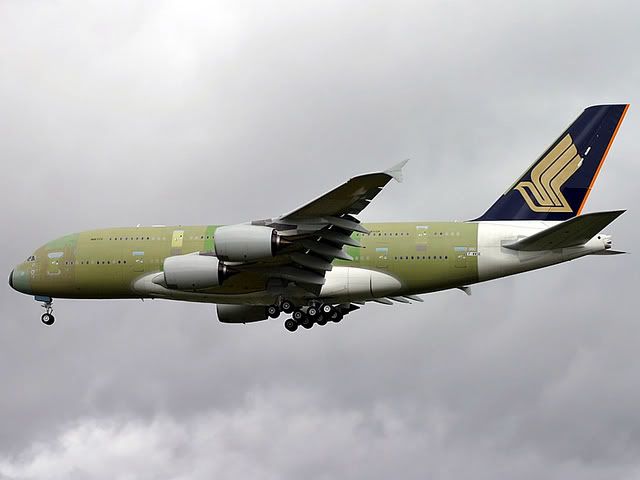
5th A380: 9V-SKE aka MSN010
NOTE: Engine and some parts not fitted yet.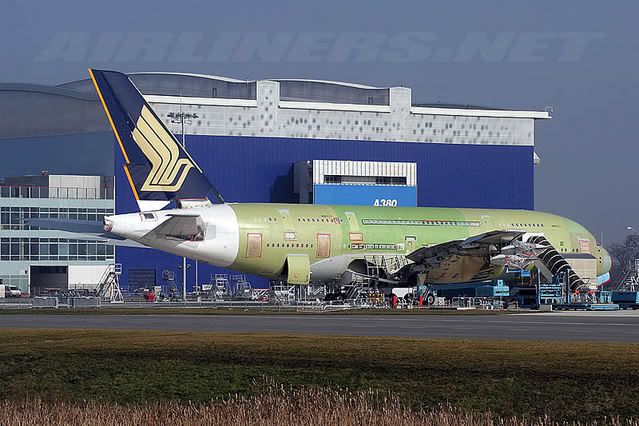
6th A380: 9V-SKF aka MSN012
NOTE: Engine and some parts not fitted yet.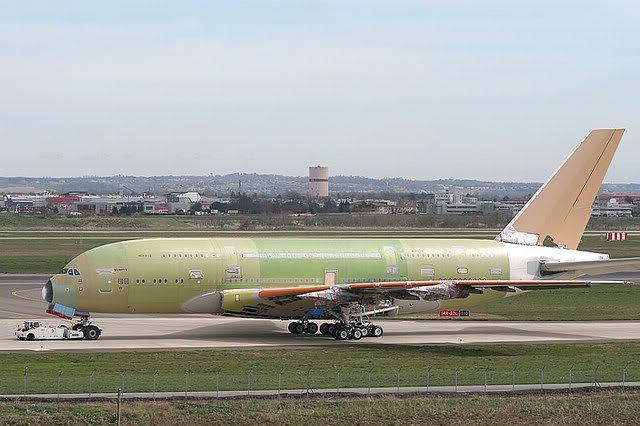
-
not to mention can earn more $$$$$$$$$$$$$$$ tooOriginally posted by alleggerita:This new A380 is meant to be greener and more fuel efficient ma..
SIA is more concern abt $$$$ ...dun everyone think so
-
Which company not concerned about revenue and profits?Originally posted by pqr:not to mention can earn more $$$$$$$$$$$$$$$ too
SIA is more concern abt $$$$ ...dun everyone think so



If you can find a company who don't bother about revenue and profits, I call you master..
-
i agree all companies want is profitOriginally posted by alleggerita:Which company not concerned about revenue and profits?


If you can find a company who don't bother about revenue and profits, I call you master..
but you said "....This new A380 is meant to be greener and more fuel efficient .."
which imply saving environment is important to SIA
no ? -
how about non-profit organisation ?Originally posted by alleggerita:If you can find a company who don't bother about revenue and profits, I call you master..
but organisation not exactly a company loh